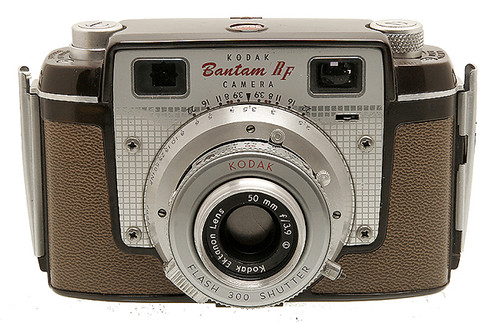Difference between revisions of "Kodak Bantam RF"
Hanskerensky (talk | contribs) m (→Links) |
(Removed link to Sylvain Halgand as it has no more info than this page) |
||
| Line 13: | Line 13: | ||
*[http://kodak.3106.net/index.php?p=209&cam=1288 Bantam RF] at Mischa Koning's Kodak Classics [http://kodak.3106.net] | *[http://kodak.3106.net/index.php?p=209&cam=1288 Bantam RF] at Mischa Koning's Kodak Classics [http://kodak.3106.net] | ||
*[http://www.butkus.org/chinon/kodak/kodak_bantam_rf/kodak_bantam_rf.htm Manual] at [http://www.butkus.org/chinon/index.html Michael Butkus Jr.'s] | *[http://www.butkus.org/chinon/kodak/kodak_bantam_rf/kodak_bantam_rf.htm Manual] at [http://www.butkus.org/chinon/index.html Michael Butkus Jr.'s] | ||
| − | |||
==Sources== | ==Sources== | ||
Revision as of 05:09, 31 January 2017
The Kodak Bantam RF of 1954-1957 was designed by Kodak's Arthur H Crapsey. It was made of brown plastic (bakelite), aluminium and other metal. It made 28×40mm exposures on Kodak's type No. 828 special 35mm paper backed roll film and was equipped with a non-self-cocking Flash 300 shutter and 50mm f/3.9 Kodak Ektanon lens. The Bantam's 3 element lens contains thorium oxide, and is in fact mildly radioactive. Like many of Kodak's more upscale offerings of the 1950's, it had an excellent optical viewfinder with superimposed coupled rangefinder. The film advance knob elevated for easier winding.

|
| image by Rick Soloway (Image rights) |
Links
- Bantam RF at Mischa Koning's Kodak Classics [1]
- Manual at Michael Butkus Jr.'s